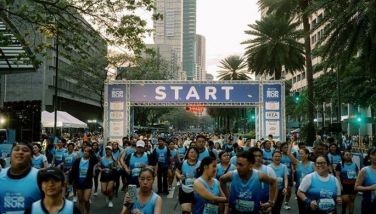The Maestro: Coach Baby D.

I wish I had more basketball books in my library, given my membership in what we here may also label as an “implicit religion” much like “AlDub.”
A book that I found so well-written and engrossing was Sacred Hoops (1996) by then Chicago Bulls coach Phil Jackson — who also earned the sobriquet Lakota Phil for his embrace of the Zen-like philosophy of the Lakota Sioux.
Add to my modest collection the coffee-table book Virgilio “Baby” Dalupan: The Maestro of Philippine Basketball, launched at the Singson Hall of Ateneo de Manila University on Oct. 19, right on the revered subject’s 92nd birthday.
I’m glad to be part of the book, too, together with other sportswriters who have lauded Baby D.’s coaching chops throughout his storied career that spanned nearly four decades. Contributors to the book also include his daughters, a rival coach and a good number of his former players.
That Monday evening of the grand launch, the venue was packed with many of these players who had been under the legendary coach’s wing.

A tarp celebrates the launching of a collectible.
I was delighted to be seated around the same table as The STAR’s dean of sportswriters Quinito Henson, Monching Cruz of Media Wise Communications and Muse Books which had designed the book, the Olympian Tony Genato who had starred as a San Beda Red Lion in the 1950s, former Toyota coach Dante Silverio who had been Baby D.’s long-time rival in the PBA, and the player who first drew attention as a game-changer when he played for the UE Red Warriors, and went on to become a byword and senator, Robert “Sonny” Jaworski.
I was pleased as punch to be greeted by him (even if he had occasionally been a pet peeve when I wrote about sports) as I stood up for a smoking break, which led to a French exit occasioned by concern over traffic build-up on Katipunan Avenue. Why, the handshake with The Big J. even led to a “duofie” care of my iPhone.
Also present that evening were Atoy Co who had just celebrated his own birthday a few days previous, Philip Cesar, Bogs Adornado, Joy Carpio, many former Blue Eagles, AdMU president Fr. Jett Villarin, S.J., his predecessor Fr. Bienvenido Nebres, S.J. (with whom I had a wonderful if brief chat), officials of the University of the East, and members of the Floro family who took up one table.
Coach Baby and his loving wife Nenang were ushered in as the hundreds of guests were moving on from cocktails to dinner, and soon emcee Sev Sarmenta embarked on the program that led to the book’s formal launch.
Lorenza “Binky” Dalupan-Palm wrote the introduction and message from the family, which reads in part:
“The Philippines is probably one of the most basketball-crazy countries in the world. Growing up as children of Baby Dalupan, the country’s leading basketball coach, watching his games behind the bench was amazingly unique and indescribably exciting.
“It was great to witness all that excitement, even greater when his teams won. But it wasn’t until we were older that we truly appreciated how much of our dad’s achievements went beyond winning his 52 championships in both the amateur and professional leagues. Not only did we learn the intricacies of game strategy and the coaching skills that made him honored as ‘The Maestro,’ we also witnessed how he was not just training his players to win games, but mentoring and forming their character with lessons for life way beyond the basketball court. His mantra was teamwork, supported by discipline, friendship, tenacity, creativity, passion, perseverance, and his own example of humility. Plus some fun and laughter here and there.
“Especially after his retirement, we felt that our dad’s life and career was a valuable story to tell. The beginnings of this book can be traced to the 2003 exhibit at the University of the East of his athletic and coaching memorabilia organized by the family for his 80th birthday, an exhibit that then moved to its permanent home — the Dalupan Room — at the Ateneo de Manila University Blue Eagles gym (formerly Loyola Center).”
Cecile also thanks Ateneo athletic director Jose “Jun-Jun” Capistrano Jr. who had urged them to produce the book, the late Raul Rodrigo for early advice, the “project team that included writers Tessa M. Jazmines and Lito Cinco, and award-winning book publisher and designer Ramoncito ‘Monching’ Cruz,” as well as the ADMU616569 Foundation which served as publisher and administrator of book project funds.
Cited are journalists Willie Caballes, Raul Gonzales, Al Mendoza, Eddie Alinea and Quinito Henson for excerpts from their articles, several players for their memories and reflections, and coach Tim Cone for his gracious foreword. She also expresses gratitude for the sponsorship provided by AdMU, UE, Lucio Tan, the family of the late Danny Floro, the Gokongweis, the Purefoods Hotdogs team, Don Jaime Zobel de Ayala, and Manuel V. Pangilinan.
It was a distinct privilege to join an illustrious roster of text contributors to the book, which also assembles quite an assortment of invaluable, mostly vintage photographs chronicling The Maestro’s inimitable career.
Quite a read does it prove to be, too. From Rick Olivares’ “Post-War Blues,” we learn of Dalupan’s early days as an athlete, as a member of the Ateneo basketball team of 1947, with Moro Lorenzo as team captain. It was during a barnstorming tour of the South that “guard Baby Dalupan would meet his future bride in Lourdes Gaston, sister of teammate Pepet, and of Choly, who would don the blue and white in a few years time.”
Baby D. was nothing less than gritty as an athlete, even given his lean frame. Olivares writes:
“The members of the 1947-48 Blue Eagles moved on to the second semester sports such as football. The Blue Booters, coached by former star player Arsenio ‘Arsenic’ Lacson — who would later become Manila’s prominent mayor and a presidential hopeful — also failed to defend their crown when they lost to La Salle 0-1 in the final game of the elimination round. Baby Dalupan was team captain that year and still wonders to this day how he made the lineup. Actually, Arsenic liked Baby’s grittiness and toughness, which the coach believed was a hallmark of a great player.
“There is no doubt that the hope and losses of 1947, together with the grittiness and toughness noted so early on by Lacson, would help Baby evolve into the great coach that he would one day become.”
Dalupan’s first stint as coach, with the UE Red Warriors, is well chronicled by Noel Albano.
“Baby Dalupan’s career as the country’s ‘winningest’ coach began at the University of the East. Taking over the coaching chores of the Red Warriors in 1955, Baby won his first championship with the University of the East (UE) in the 1956 National Inter-Collegiate tournament. From then on, there was no stopping Baby. The following year, the Dalupan-led Red Warriors won their first University Athletic Association of the Philippines (UAAP) title and went on to become one of the most successful collegiate teams of the country, winning a total of twelve UAAP championships, including seven straight titles from 1965 to 1971, and six National Intercollegiate titles.”
So interestingly, Albano details:
“(B)eing always handicapped by their smaller size, the Warriors were forced to play slow ball. This concept of team offense was about to be overturned by the new 30-second shot clock introduced in 1957. In his understated way, Dalupan, an innovator and a tinkerer, began shaking things up. With one adjustment, in one inspired moment, he altered the zone defense. He introduced the most outstanding feature of the man-to-man, so that his team defense no longer could be called a pure zone. This was after his sophomore year, when he enriched the game’s nomenclature with a hybrid defense he called zone-man.
“‘I happened to see that when you play a straight zone, you don’t have any man in front of you, so it was easy to break,” recalled Baby. ‘This made me think of going into the improved defense.’ The way it worked, it began as a zone. ‘But you have a man,’ he said, ‘and the attacking team could only break the defense if the point guard or the big guard would go in and try to go to the basket. The adjustment is, the man in front of him has to follow… They (attacking team) could not break the defense if they really don’t move around very well.’”
Of course Baby Dalupan moved on to partner with team manager Danny Floro behind “arguably the most successful basketball club in Philippine basketball” — the Crispa Redmanizers, which won 16 amateur league championships before joining the Philippine Basketball Association (PBA) professional league in 1975.
“Crispa accomplished the legendary feat of winning the league’s first ever Grand Slam sweep of all three conferences in 1976. Under the Dalupan-Floro partnership, Crispa went on to garner a total of nine PBA championships, including a standing record of six straight titles from 1975 to 1977.”
In the PBA, The Maestro also carved out championships for the Great Taste Coffee Makers and Purefoods Hotdogs, and for the Ateneo Blue Eagles in the UAAP. He also coached five national teams, from the World Championships in Chile in 1959 to the Peta Sukan in Singapore in 1971 and 1972.
So many other interesting details fill up the 235-page book, surely a must for any sports lover’s library. And such were the span, scope, breadth and depth of this man’s coaching career, as mentor, as inspirational leader, that he truly deserves his title of “The Maestro.”



















